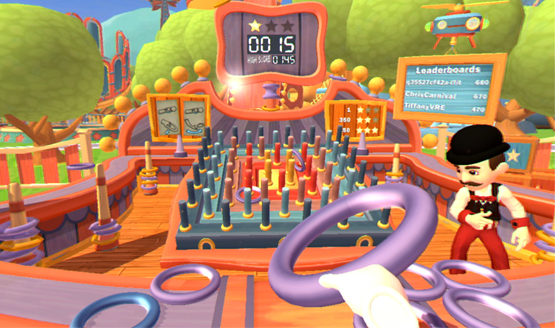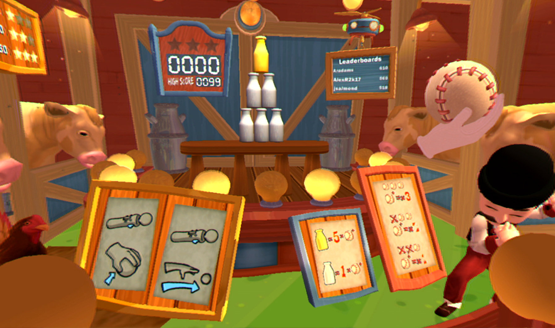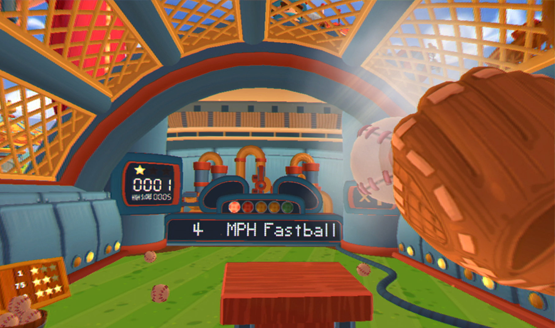Hey! You there! Step right up! Throw a ball at this stack of milk bottles and win a fantastic prize! Maybe try your hand at the ring toss? How about a classic game of skeeball? Carnival Games VR has all of these and more, complete with carnival barker and bizarre patrons milling about. It may just be a series of minigames, but how does the experience translate to the presence and immersion of the PlayStation VR headset? Let’s grab ourselves a day pass and a funnel cake and head to the carnival.
Carnival Games VR doesn’t mince words about exactly what it is. It’s a series of popular carnival games, presented in virtual reality. The simple title is a modest kind of tricky, however. It may not share the kind of brand power that Batman: Arkham VR or Until Dawn: Rush of Blood have. It certainly isn’t about spaceships or mechs (unless you count the prizes you can win). It doesn’t award a deep narrative, or even a social experience. And yet, it shouldn’t be written off for being exactly what it is — carnival games. Instead it should be embraced as one of the most fundamental VR experiences, linking itself with our primal core.
The Why of Simplicity
Why do carnival games still exist today? I mean real ones, not this game. Go to a state fair and you’ll find yourself paying $5 to throw a few balls at a tower of milk bottles or tossing some rings into a sea of pegs. We’ve got cinematic masterpieces, virtual reality, and high quality mobile titles now, yet these classics still pervade society. I’m sure I could do a deep dive into the psychology of carnival games and why these primordial distractions keep us so, well, distracted, but the high level explanation is that they are short simple tests of our own skills, triggering that sensation in the brain for instant gratification.
Let’s take the milk bottles again as an example. Pick up a ball, throw it at the stack. Did you hit it? You can instantly answer that question yes or no, and you can immediately pick up another ball and try again. If you do manage to knock them over, you get an oversized stuffed animal as proof of your conquests. This whole process takes a matter of less than a couple of minutes, before you’re moving on to the next showcase of a particular skill, whether it be hand-eye coordination, strength, speed, balance, or any other basic human survival skills that we’ve evolved to see as necessary since the dawn of man. The guy running the game is happy too, since he probably swindled you out of five bucks by filling the bottoms of the milk bottles with lead.
We’re still talking about video games, right? Yes, we are. Carnival Games VR scratches the itch on that axiomatic foundation by furnishing a digital carnival full of elementary gaming experiences. You’e got your milk bottles, ring toss, and skeeball, and there are even some more complex ones like target shooting — both stationary and on a haunted house ride. At the end of each game your score is displayed, tickets are earned to purchase prizes, and it’s far too easy to hit retry and aim for an even higher score, convincing yourself that you can catch more balls in fast pitch or pop more balloons in darts. Fortunately the only cost of entry is the price of the game and time you spend playing, so you don’t need to worry about losing all your money trying to prove your mettle.
It’s quite amazing how cathartic I find coming home and jumping into Carnival Games VR to be. I’ve spent hours in it without realizing that time was passing, often with large chunks of time spent playing and replaying the same games, seeking improvements on my own skill. The deeply engaging sensation implicit to virtual reality experiences amps Carnival Games VR’s ability to be both straightforward and magnetic without the need for fancy brands or high tech intensity. The broadly recognizable experiences are more than enough to grab any player’s attention and hold on. This isn’t something to play when you want to play a video game with a controller. This is something to play when you literally want to play carnival games in their full glory.
Raining on the Parade
For a game that touts itself as a fun and bright party game though, it would have been nice to have a better set up to be able to play in a party environment (multiple in-game profiles, local high scores, social screen interaction using the DualShock 4 etc.), especially because right now the only real options for local PSVR party games are PlayRoom VR and Keep Talking and Nobody Explodes — both excellent experiences. Right now Carnival Games VR is limited by only being able to pass the headset from one player to the next, and the top three world scores are the only kind of online rankings, leaderboards, or play. It’s one of the biggest hurdles of VR right now, trying to make sure that a sense of immersion doesn’t end up being solely a sense of seclusion or exclusion in every experience.
Considering the physical stipulations of most carnival games, Carnival Games VR is one of PlayStation VR’s titles that does require Move controllers to play. The DualShock 4 would have severely limited the concept however (why play in VR if you are just going to be using the control sticks and buttons to do things anyway?), so it makes sense that they focused on developing for the Move. As luck and hard work would have it, Carnival Games VR has some of the best tracking work of any game I’ve played on PlayStation VR. Once you adjust to the in-world physics, which are slightly whimsical, precision of ball throws draws a sense of relation to the surroundings, and accuracy of ring tosses makes it feel like I am really there. The only one that felt less than ideal (actually almost unplayable) was the darts game that tended to glitch when the Move crossed near the VR headset, but these issues rarely bled over to the other games. One of my favorites is the incredibly taxing wall climb game that physically tired me out as I scaled a virtual wall, at one point sending my light fixture crashing down from the ceiling as I lunged for the next hand hold. Oops.
Carnival Games VR shouldn’t be counted out because of its simplicity. In fact, it’s that very nature that makes it one of the must have experiences on PlayStation VR. The 12 games each provide distinct experiences that are addicting in their own ways, some more than others. Instant gratification keeps me hitting retry for just one more throw, one more minute, one more ride, and before I know it I’ve lost time to the coalescing of those primal parts of myself and the presence of virtual reality. Tracking isn’t perfect in all games, and the social multiplayer aspects could be built out a little more, but the core accomplishments of Carnival Games VR demonstrate at a psychological level why VR is a fundamentally different kind of experience from flatscreen 2D gaming.
Carnival Games VR review copy provided by publisher. For more information on scoring please see our Review Policy.
-
Simple yet engaging
-
The high score itch elicits a "one more try" mentality
-
The wall climb game
-
Darts tracking is terrible
-
No local or online multiplayer structure aside from high scores










